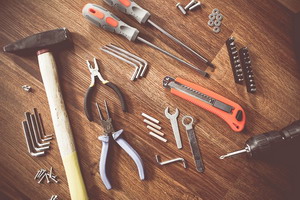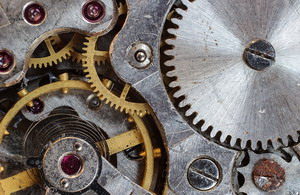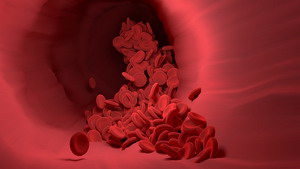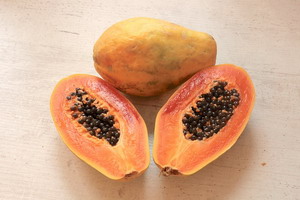 Enzymes are the physical essence of life in our bodies. They are the microscopic tools and engines that build everything and run everything. Enzymes act as the army of tiny worker minions that fill all the blue-collar jobs in the body that get everything done. We think of the DNA as the master blueprint inside of each cell, but what the DNA is a blueprint for is mostly making enzymes.
Enzymes are the physical essence of life in our bodies. They are the microscopic tools and engines that build everything and run everything. Enzymes act as the army of tiny worker minions that fill all the blue-collar jobs in the body that get everything done. We think of the DNA as the master blueprint inside of each cell, but what the DNA is a blueprint for is mostly making enzymes.
 Enzymes are proteins, chains of amino acids that connect into thousands of shapes to do various specific jobs. Each shape is a specific enzyme. Some enzymes weld chemical stuff together to make structures inside of cells. Other enzymes tear things apart to make big chemicals and structures into smaller parts. Still, other enzymes add energy molecules to molecular structures so they will change shapes creating movement. Enzymes act as catalysts to make things happen. Chemical interactions that if left to chance might only happen once in a million years can be made to happen thousands of times each second with the proper enzymes involved. They make life possible.
Enzymes are proteins, chains of amino acids that connect into thousands of shapes to do various specific jobs. Each shape is a specific enzyme. Some enzymes weld chemical stuff together to make structures inside of cells. Other enzymes tear things apart to make big chemicals and structures into smaller parts. Still, other enzymes add energy molecules to molecular structures so they will change shapes creating movement. Enzymes act as catalysts to make things happen. Chemical interactions that if left to chance might only happen once in a million years can be made to happen thousands of times each second with the proper enzymes involved. They make life possible.
 Most enzymes are made inside each cell and are used to do jobs only inside the cell. But some enzymes function outside cells to do a variety of important jobs in the body. Two classes of enzymes I want to focus on today are digestive enzymes and systemic proteolytic enzymes. The first set is used by the body to help you digest your food while the second set gets into your bloodstream to support a variety of bodily functions.
Most enzymes are made inside each cell and are used to do jobs only inside the cell. But some enzymes function outside cells to do a variety of important jobs in the body. Two classes of enzymes I want to focus on today are digestive enzymes and systemic proteolytic enzymes. The first set is used by the body to help you digest your food while the second set gets into your bloodstream to support a variety of bodily functions.
 Let’s start with digestive enzymes. As you know, the food sitting on your plate can not be put as is into your bloodstream to feed you. It would kill you instead. The food first has to be broken down into the tiny sub-units that make it up, generally sugar, amino acids, and fatty acids. Plants are mostly made up of various types of sugar that are bound into long branched chains forming starches and fibers. Some plants can form fatty acids, such as olives, coconuts, and avocados in large quantities. Fats are primarily concentrated energy sources for plants just like they are for humans. Every plant has tiny amounts of amino acids that form proteins, but generally, the concentration is very tiny except in the seeds of the plant. Animals can convert these plant components and form mostly protein and fat. The formation of these starches, fibers, fats, and proteins are all managed and supported by cellular enzymes. Animals like us need to be able to take these complex plant structures and break them back down into their simple building blocks before we can absorb them through our gut wall and into our bloodstream. This is where digestive enzymes enter the picture.
Let’s start with digestive enzymes. As you know, the food sitting on your plate can not be put as is into your bloodstream to feed you. It would kill you instead. The food first has to be broken down into the tiny sub-units that make it up, generally sugar, amino acids, and fatty acids. Plants are mostly made up of various types of sugar that are bound into long branched chains forming starches and fibers. Some plants can form fatty acids, such as olives, coconuts, and avocados in large quantities. Fats are primarily concentrated energy sources for plants just like they are for humans. Every plant has tiny amounts of amino acids that form proteins, but generally, the concentration is very tiny except in the seeds of the plant. Animals can convert these plant components and form mostly protein and fat. The formation of these starches, fibers, fats, and proteins are all managed and supported by cellular enzymes. Animals like us need to be able to take these complex plant structures and break them back down into their simple building blocks before we can absorb them through our gut wall and into our bloodstream. This is where digestive enzymes enter the picture.
 Digestive enzymes are primarily produced in our mouth, stomach, and by the pancreas at our duodenum just below the stomach. Digestive enzymes are all types of enzymes that tear things apart. Enzymes in the mouth are for breaking apart simple starches. These enzymes need a neutral pH environment – not acidic or alkaline. You can notice these enzymes in action if you chew a piece of bread or pasta for a long time. Gradually it will start to taste sweet. This is because the mouth enzymes are breaking little pieces of sugar off of the starch molecules.
Digestive enzymes are primarily produced in our mouth, stomach, and by the pancreas at our duodenum just below the stomach. Digestive enzymes are all types of enzymes that tear things apart. Enzymes in the mouth are for breaking apart simple starches. These enzymes need a neutral pH environment – not acidic or alkaline. You can notice these enzymes in action if you chew a piece of bread or pasta for a long time. Gradually it will start to taste sweet. This is because the mouth enzymes are breaking little pieces of sugar off of the starch molecules.
 The stomach is for starting the breakdown of proteins. Because proteins may be thousands of amino acid molecules long and are folded up into complex patterns, high amounts of acid are needed to cause the 3D structure of the proteins to unfold. This is because of something called hydrogen bonding which holds the 3D structure in its shape. As the protein unfolds, it exposes its inner structure to the action of the powerful stomach enzymes for breaking down proteins into smaller amino acid pieces called peptides. This requirement for a high-acid environment is a major reason for many GI complaints. If the acid is not strong enough in the stomach, then most of the protein you eat can not be digested properly. The net result is that large chunks of protein then travel through the digestive tract down to the large intestine where nasty unhealthy bacteria break it down for themselves. We use a simple at-home stomach acid test to check for this problem.
The stomach is for starting the breakdown of proteins. Because proteins may be thousands of amino acid molecules long and are folded up into complex patterns, high amounts of acid are needed to cause the 3D structure of the proteins to unfold. This is because of something called hydrogen bonding which holds the 3D structure in its shape. As the protein unfolds, it exposes its inner structure to the action of the powerful stomach enzymes for breaking down proteins into smaller amino acid pieces called peptides. This requirement for a high-acid environment is a major reason for many GI complaints. If the acid is not strong enough in the stomach, then most of the protein you eat can not be digested properly. The net result is that large chunks of protein then travel through the digestive tract down to the large intestine where nasty unhealthy bacteria break it down for themselves. We use a simple at-home stomach acid test to check for this problem.
 Once the first stage of breakdown occurs in the stomach, then the protein/peptide mush slides down into the duodenum. Here the acid is neutralized by strong alkaline juice from the pancreas and then attacked by a whole slew of different enzymes from the pancreas that break the peptides down into individual amino acids. These enzymes don’t work in an acidic environment. They need either neutral or alkaline fluid to work in. If you take digestive enzymes pills to help your digestion, this acid problem is why you need to take the pills before you eat, before any acid is released by the stomach. Why might you need to take such pills? The answer is that your pancreas is not producing or possibly not releasing enough enzymes to do the job. Stress is one good cause of this. These enzymes are only produced and released while you are relaxed. If you are stressed while you eat, good digestion just does not happen.
Once the first stage of breakdown occurs in the stomach, then the protein/peptide mush slides down into the duodenum. Here the acid is neutralized by strong alkaline juice from the pancreas and then attacked by a whole slew of different enzymes from the pancreas that break the peptides down into individual amino acids. These enzymes don’t work in an acidic environment. They need either neutral or alkaline fluid to work in. If you take digestive enzymes pills to help your digestion, this acid problem is why you need to take the pills before you eat, before any acid is released by the stomach. Why might you need to take such pills? The answer is that your pancreas is not producing or possibly not releasing enough enzymes to do the job. Stress is one good cause of this. These enzymes are only produced and released while you are relaxed. If you are stressed while you eat, good digestion just does not happen.
 Since we are on the subject of taking enzyme pills, let’s look at another set of enzymes that have great usefulness when taken on an empty stomach. Generally, I am talking about proteolytic enzymes, which are enzymes for breaking down proteins. Except in this case we are using them to work on proteins in other places in the body than the digestive tract. Some of these can be found naturally in certain foods like pineapple (bromelain), papaya (papain), and fermented soybeans (nattokinase). Others come from such things as silkworms (serrapeptase) and earthworms (lumbrokinase). The most general use for these enzymes is to reduce inflammation in the body, something we all need. But their uses go far beyond this. Each enzyme is a tool that uncouples one specific molecular bond. There are thousands of types of molecules in the body, thus the need for so many kinds of enzymes. Since our body is made of protein, the enzymes that break down specific proteins will have many jobs they can do.
Since we are on the subject of taking enzyme pills, let’s look at another set of enzymes that have great usefulness when taken on an empty stomach. Generally, I am talking about proteolytic enzymes, which are enzymes for breaking down proteins. Except in this case we are using them to work on proteins in other places in the body than the digestive tract. Some of these can be found naturally in certain foods like pineapple (bromelain), papaya (papain), and fermented soybeans (nattokinase). Others come from such things as silkworms (serrapeptase) and earthworms (lumbrokinase). The most general use for these enzymes is to reduce inflammation in the body, something we all need. But their uses go far beyond this. Each enzyme is a tool that uncouples one specific molecular bond. There are thousands of types of molecules in the body, thus the need for so many kinds of enzymes. Since our body is made of protein, the enzymes that break down specific proteins will have many jobs they can do.
 The first area of action for these enzymes that cross the gut barrier and get into the bloodstream is in our blood itself. Most of them help prevent blood clots and thus strokes that come from clots. Research has shown that these enzymes are potential replacements for blood-thinning drugs like Coumadin and heparin. Additionally, these enzymes help eat away the clogging of the arteries in atherosclerosis so they are great for treating cardiovascular disease. Unfortunately, as these are natural substances, your medical doctor can not prescribe them for you. They are restricted to prescribing only approved drugs. These enzymes are considered safe for most people to take, but if you are already on a blood-thinning drug then you would not want to take these at the same time.
The first area of action for these enzymes that cross the gut barrier and get into the bloodstream is in our blood itself. Most of them help prevent blood clots and thus strokes that come from clots. Research has shown that these enzymes are potential replacements for blood-thinning drugs like Coumadin and heparin. Additionally, these enzymes help eat away the clogging of the arteries in atherosclerosis so they are great for treating cardiovascular disease. Unfortunately, as these are natural substances, your medical doctor can not prescribe them for you. They are restricted to prescribing only approved drugs. These enzymes are considered safe for most people to take, but if you are already on a blood-thinning drug then you would not want to take these at the same time.
 Numerous studies have shown proteolytic enzymes reduce healing time for injuries by as much as 50%, reduce muscle and joint pain, and reduce scar tissue. It seems that many of my patients live in daily pain and restriction simply because of old scar tissue in muscles and joints left over from old injuries. In the office, I will use a guasha tool to break up some of this in the shoulders, but I do not go for the deep stuff in the hips and even the gut region as this would be too painful to treat. Using enzymes for about a year is a great way to slowly eat away these old knots of scar tissue glue throughout the body in those people that have old sports injuries or unresolved auto accident injuries. This level of treatment is slow and takes a bit of time. Conversely reducing inflammation with enzymes happens almost right away – within a day or two.
Numerous studies have shown proteolytic enzymes reduce healing time for injuries by as much as 50%, reduce muscle and joint pain, and reduce scar tissue. It seems that many of my patients live in daily pain and restriction simply because of old scar tissue in muscles and joints left over from old injuries. In the office, I will use a guasha tool to break up some of this in the shoulders, but I do not go for the deep stuff in the hips and even the gut region as this would be too painful to treat. Using enzymes for about a year is a great way to slowly eat away these old knots of scar tissue glue throughout the body in those people that have old sports injuries or unresolved auto accident injuries. This level of treatment is slow and takes a bit of time. Conversely reducing inflammation with enzymes happens almost right away – within a day or two.
 The easiest entry into using enzymes is eating pineapple or papaya on an empty stomach and seeing how you feel. These are the gentlest enzymes. From there you can ramp up to nattokinase, serrapeptase, or lumbrokinase for stronger effects. Ellen has used nattokinase ever since her stroke seven years ago to keep her blood from clotting, and she does not get the easy bruising I see on folks that take drug blood thinners. I use the lumbrokinase daily to work on keeping my arteries clean. Recently Ellen had an ultrasound inspection of her major arteries and her results came back showing she has the arteries of a 20-year-old. Something must be working.
The easiest entry into using enzymes is eating pineapple or papaya on an empty stomach and seeing how you feel. These are the gentlest enzymes. From there you can ramp up to nattokinase, serrapeptase, or lumbrokinase for stronger effects. Ellen has used nattokinase ever since her stroke seven years ago to keep her blood from clotting, and she does not get the easy bruising I see on folks that take drug blood thinners. I use the lumbrokinase daily to work on keeping my arteries clean. Recently Ellen had an ultrasound inspection of her major arteries and her results came back showing she has the arteries of a 20-year-old. Something must be working.
Take care,
David
